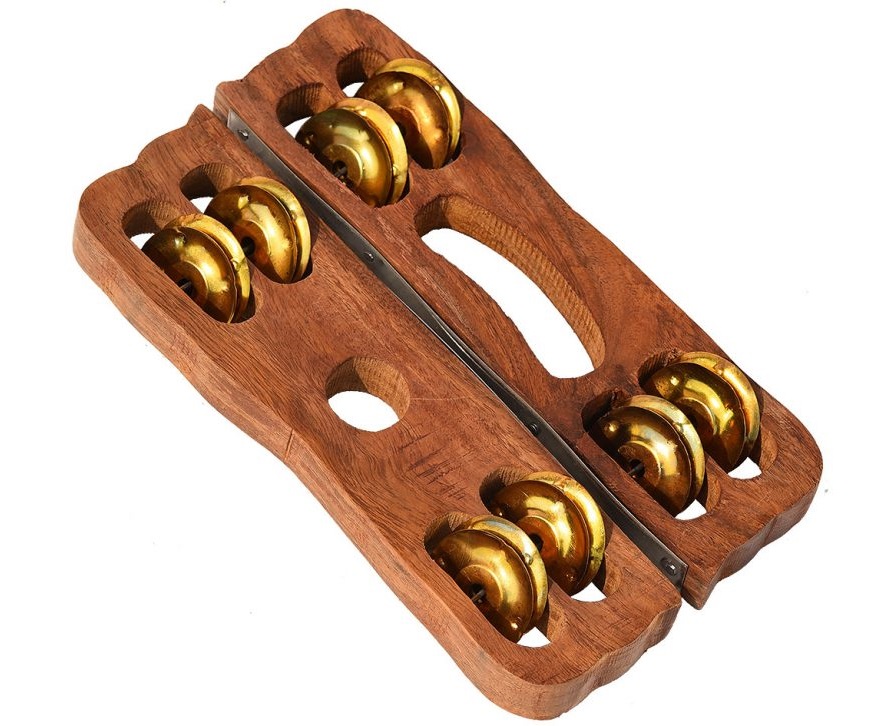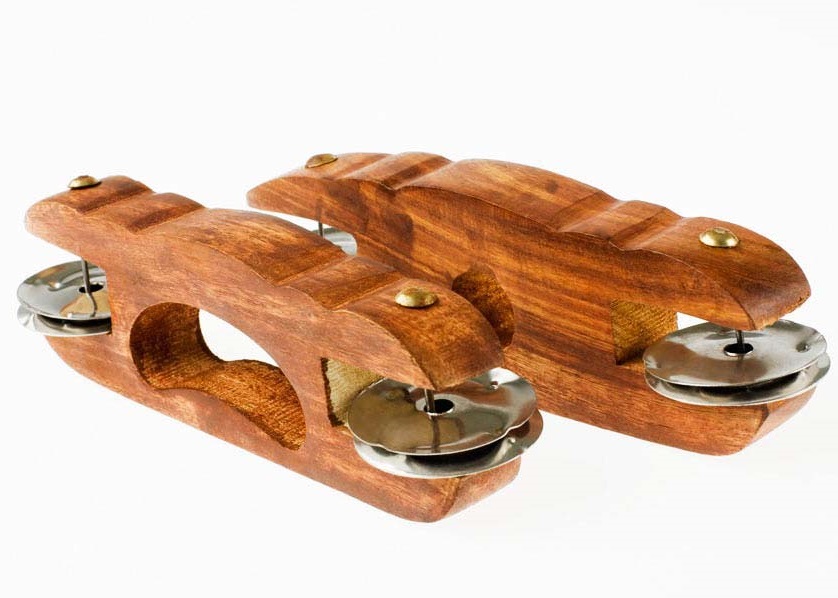Khartal
Percussions
Asia
Between 0 and 1000 AD
Video
The Khartal is a traditional percussion instrument, commonly found in the folk and devotional music of India. It is a simple yet effective instrument, producing rhythmic sounds when struck or shaken. The name “Khartal” is derived from Sanskrit, where “Khar” means hand, and “Taal” refers to rhythm or beat. This instrument has been used for centuries in various musical traditions, from classical performances to folk dances and religious rituals.
The Khartal is classified as an idiophone, meaning it produces sound through the vibration of its own material rather than through strings, membranes, or air columns. It consists of a pair of wooden or metallic pieces that create a sharp, percussive sound when played together. This instrument is widely used in devotional music, particularly in bhajans, kirtans, and Sufi music, where it provides a rhythmic base to accompany singing and other instruments.
Khartal is one of the simplest and most portable percussion instruments, making it a preferred choice for musicians who need a rhythmic accompaniment without carrying bulky instruments. Though it might appear basic, playing the Khartal requires skill and technique to maintain consistent rhythm and tempo.
History and Origin
The history of the Khartal dates back to ancient times, with its origins deeply rooted in the Indian subcontinent. It is believed to have emerged as a primary percussion instrument used in devotional and folk music traditions. Its exact century of origin is difficult to determine, but references to similar percussion instruments can be found in ancient Indian scriptures and carvings, suggesting that the Khartal has been in use for several thousand years.
The earliest references to hand-held percussion instruments similar to the Khartal can be traced to the Vedic period (1500 BCE – 500 BCE), where music played a significant role in religious ceremonies and storytelling traditions. Instruments like the Manjira and Kartal (wooden clappers with cymbals) were commonly used in temples, folk gatherings, and spiritual congregations. During the medieval period (12th – 17th century), the Khartal became an integral part of Sufi music and Bhakti movement traditions. Devotees and wandering saints used the instrument in their spiritual songs and hymns. It became particularly popular in the Rajasthan and Gujarat regions, where folk musicians incorporated it into their performances. Over time, different styles of Khartal playing evolved, each with unique techniques and expressions.
The instrument also gained prominence during the Mughal era (16th – 18th century), as court musicians integrated Khartal rhythms into classical compositions. Today, the Khartal remains an essential element in various Indian musical traditions, continuing to be played in religious ceremonies, folk performances, and even modern fusion music.
Types and Features
There are different types of Khartals based on their construction, material, and regional variations. While the fundamental mechanism of all Khartals remains the same, the type of material used influences the sound quality and playing technique.
Material-Based Variations
The most common type, made from high-quality hardwood like teak or rosewood. These Khartals are lightweight and produce a warm, natural tone. They are commonly used in Rajasthani folk music and devotional songs. Metallic Khartal is made of brass, bronze, or iron, these Khartals produce a sharper, more ringing sound. They are often used in temple music and Sufi traditions, where the metallic resonance adds to the spiritual ambiance. Hybrid Khartal (Wood and Metal) is a combination of wood and metal, where wooden frames hold small metallic jingles or cymbals. This type produces a rich sound that blends both wooden and metallic tones.
Regional Variations
Rajasthani Khartal
Used primarily in Manganiyar and Langa music, this style of Khartal is lightweight and allows for fast, intricate playing techniques.
Gujarati and Kathiyawadi Khartal
Found in Gujarat, it is larger in size and often used in Garba and Dandiya performances, adding rhythm to the high-energy dance music.
South Indian Khartal
Similar to Taalam used in Carnatic music, this variation has a unique playing style that is integrated into classical performances.
Work Mechanics
The Khartal functions through the principle of percussive impact and vibration. It is played by holding the pieces in both hands and striking them against each other in rhythmic patterns. The way it is played varies depending on the style of music and the dexterity of the performer.
Hand Techniques
Basic Strike – The simplest technique, where two pieces are struck together to create a basic beat. Rolling Effect – Rapid successive strikes to produce a continuous rhythm. Muted Strike – A softer, dampened sound achieved by adjusting the grip and force applied. Dynamic Variation – Players modulate the sound by varying the angle and speed of the strike.
The playing style of Khartal is often compared to the tabla or dholak, where rhythmic cycles (taals) are maintained. Skilled players can produce fast, complex rhythms that accompany traditional singing and dancing.
Role in Music
The Khartal has a significant role in multiple musical traditions, serving as a rhythmic foundation for both devotional and folk performances.
Devotional and Spiritual Music
Bhajans and Kirtans – Used in Hindu spiritual gatherings, especially in Vaishnav and ISKCON movements, where it complements the chanting of holy names. Sufi Music and Qawwali – The Khartal plays an essential role in Sufi performances, providing rhythm for the deeply spiritual and poetic singing style. Temple Music – In South India, it is often played during pujas and religious ceremonies, creating an uplifting and divine atmosphere.
Folk and Traditional Music
Rajasthani Folk Music – Played by Manganiyars and Langas, who combine it with instruments like the Sarangi and Morchang.
Bengali Baul Music – Used by Baul singers, wandering mystics who use the Khartal as their main percussion accompaniment.
Garba and Dandiya Raas – Common in Gujarati celebrations, where its sharp beats match the energetic dance steps.
In many folk traditions, the Khartal is played alongside other instruments such as Dhol, Manjira, and Harmonium, creating a complete musical ensemble.
Significance of Khartal
The significance of the Khartal extends beyond just its musical role. It carries cultural, spiritual, and artistic value, making it an indispensable part of traditional Indian music. The Khartal symbolizes the simplicity and purity of folk traditions. Unlike complex classical instruments, it is accessible to anyone, requiring only rhythm and dedication to master. It represents the heritage of Rajasthan, Gujarat, and Bengal, where it has been played for centuries in festivals, weddings, and processions.
In religious contexts, the Khartal is believed to have divine associations. It is considered a sacred instrument, often used in bhakti (devotion) and sufi (mystic) traditions to bring the performer and listeners closer to the divine. The rhythmic beats are said to induce a meditative state, helping people immerse themselves in prayer and worship.
Artistic Contribution: The Khartal is not just a rhythmic device but also an expression of art and storytelling. In folk performances, musicians use it to convey emotions, set the tempo, and create dramatic effects that enhance the performance. Its adaptability allows it to be used in modern fusion music, blending with contemporary instruments while preserving its traditional essence.
FAQ
What is the significance of the khartal in Indian music?
The khartal is significant in Indian music for its role in folk and devotional songs, providing rhythmic accompaniment to instruments like the tabla and harmonium. Its portability and simplicity make it a popular choice for musicians across various genres.
How does the khartal produce sound?
The khartal produces sound through the clapping of two wooden sheets or blocks together. This action creates a percussive sound, allowing for a variety of rhythmic patterns.
What are the different types of khartal instruments?
There are primarily two types of khartal: the traditional wooden clappers and the shaken khartal, which includes metal cymbals. The wooden clappers are the most common, while the shaken khartal is similar to a tambourine.
 Links
Links
References
Other Instrument
Categories



















